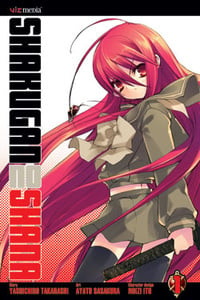Review
by Theron Martin,Shakugan no Shana
GN 1
| Synopsis: |  |
||
Yuji Sakai expected just another ordinary year at school, but that all changed when a magical seal surrounded the street around him and monsters appeared, apparently intent on eating the essence of the people around him. Although apparently saved from a similar fate by a flame-haired girl wielding a sword, Yuji soon discovers that the “real” Yuji is, in fact, already dead, and that he is just an echo of the original known as a Torch, which exists to ease the harm done to reality by having a person gradually fade from existence instead of suddenly being removed. He also soon discovers that he is a special case known as a Mistes, which means that he has a special magical treasure at the core of his being. That makes him a target for Crimson Denizens from the neighboring Crimson World, so the flame-haired girl, known as a Flame Haze (a former human who has become the vessel for a Crimson Lord, individuals from the Crimson World who oppose the Crimson Denizens), sticks close by him to guard him against Crimson Denizens and their damaging ways, even going so far as to assume the existence of a classmate of Yuji's whose existence had faded away. Since she doesn't have a name, Yuji dubs her Shana, after the name of her sword. |
|||
| Review: | |||
Based on an immensely popular Japanese novel, the manga version of Shakugan no Shana preceded the initial broadcast of the anime version by several months. It roughly equates to episodes 1-3, parts of episode 4, and bits from a couple of later episodes of the anime, telling more or less the same story but with some significant differences on the details and order of events. It is also, by almost any reasonable standard, the inferior version of the two. This is not to say that the manga doesn't tell an intriguing story; the whole business about Torches, Crimson Denizens, and Flame Hazes provides an interesting variation on standard magic-juiced action stories, and it suffers from no lack of action content. And, in fact, it's done well enough that someone who has not been exposed to the anime is unlikely to notice any problem. Upon comparison, though, the manga version moves along a bit too fast, not stopping to take time and develop characters and situations fully. The anime does do that, even devoting most of its second episode to exploring the tragic situation of Yuji's classmate Yukari, an incident wholly absent from the manga. Such examinations lend to the anime version quite a bit more depth, and a more genuinely tragic feel, than the manga ever generates. The anime version also much more fully realizes some personalities than the manga version. A good bit of Shana's blunt, acerbic behavior does come through in the manga, but it is not nearly as sharply-defined as it is in the anime, nor does Friagne's creepy doll fetish have its full impact without vocals to lend the right tone. Although most other characters of consequences are represented about equally well in both versions, the comparative deficiencies in those two roles makes quite a bit of a difference. The manga also seems to take itself a bit less seriously than the anime does. While the anime has some light-hearted content, much more of it appears in the manga, although Shana's trademark “Shut up! Shut up! Shut up!” takes quite a bit longer to appear. The prominence of fan service elements remains about the same in both. In general, though, the writing of Yashichiro Takahashi stands at least a step below the anime series writing in any qualitative terms. The character designs by artist Ayato Sasakura favor round-headed, big-eyed, thin-necked, and petite-framed depictions that are slightly more caricaturish than the norm for anime. Not unappealing, but again, not as sharp as the designs in the anime, and the lack of color can be felt strongly in scenes where Shana's hair is supposed to be flaming. Background art never holds more detail than absolutely necessary, and magical effects used in the action scenes lack a sense of grandeur and wonder. The action scenes are handled well enough, but still pale in comparison to their renditions in the anime version. The manga's worst trait is a bad tendency to grossly overuse words for emphasizing and/or describing actions; is it really necessary to give a “glare” or “stare” comment when the artwork makes it clear what the character is doing? Fortunately Viz Media's release of the title does translate both those and the many sound effects in styles that mimic those of the originals, which otherwise might have turned the title into a distracting mess. It does not offer any extras beyond brief writer and artist comments, however, nor is the glossy color cover art particularly impressive. As a stand-alone entity the first volume of the Shakugan no Shana manga might be mildly entertaining, but it does not grip the reader as thoroughly as the anime version can and is best looked upon as an alternate version of the anime (even though it did come first). If this is your first exposure to the franchise, look to the anime version to see it done right. |
| Grade: | |||
|
Overall : B-
Story : B-
Art : B-
+ Interesting premise and heroine. |
|||
| discuss this in the forum (6 posts) | | |||
| Production Info: | ||
|
Full encyclopedia details about Release information about |
||